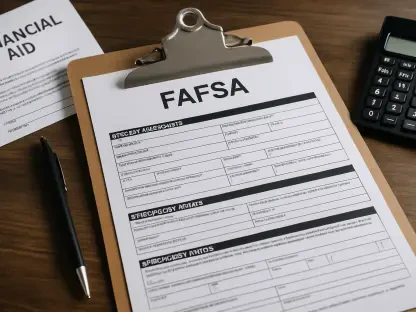Camille Faivre is an Education expert with a focus on education management. In the post-pandemic landscape, she supports institutions in the development and implementation of open and e-learning programs. Today, she provides insights into the recent situation involving Anderson Union High School District (AUHSD) and the Shasta County Community Schools Consortium, particularly regarding the disruption of services from the Community Connect program.
Can you describe the services provided by the Community Connect program and how they specifically benefit students and families?
The Community Connect program is designed to offer a referral system for families experiencing challenges such as food insecurity and housing instability. This program connects those in need with a wide range of services and resources, including case management and access to essential support systems. By doing so, it ensures that students can continue their education without the added stress of basic needs insecurity, which significantly benefits both students and their families.
What led to Anderson Union High School District’s decision to remove their schools from the Shasta County Community Schools Consortium?
AUHSD decided to remove their schools due to concerns over potential liability issues associated with remaining in the consortium. The decision was made after a series of board meetings where these concerns were discussed and ultimately resulted in a vote to withdraw.
How did the removal from the consortium impact AUHSD’s access to Community Connect services?
Following AUHSD’s withdrawal from the consortium, they lost access to Community Connect services. This was a direct consequence of the district’s removal, impacting the availability of the referral system and related support services for AUHSD students and families.
Superintendent Brian Parker, can you explain the initial expectations AUHSD had regarding continued access to Community Connect services after leaving the consortium?
Initially, Superintendent Parker and the AUHSD board members believed that the schools would retain access to Community Connect services even after leaving the consortium. This expectation was based on a January meeting where they were informed that withdrawal from the consortium would not affect their participation in the Community Connect program.
Superintendent Mike Freeman, why was AUHSD specifically excluded from using Community Connect services post their decision to leave the consortium when other non-member districts still have access?
Superintendent Freeman explained that the exclusion of AUHSD was due to the funding structure. Community Connect services are supported by the Community Schools Grant, which AUHSD chose to opt out of. Consequently, without those funds, SCOE could not provide the services to AUHSD specifically.
Can you elaborate on the funding challenges faced by SCOE that affected the availability of Community Connect services?
SCOE faced significant funding challenges after the Board of Supervisors modified the existing contract with the Department of Health and Human Services in 2024. This led to a reliance on the Community Schools Grant for funding the Community Connect services, limiting their ability to extend these services to districts that opted out of the grant, like AUHSD.
Did SCOE foresee any potential negative consequences for AUHSD as a result of their withdrawal from the Community Schools Consortium in terms of resource allocation?
While SCOE acknowledged the potential for negative consequences, the situation was compounded by inadequate communication and a lack of clarity about funding impacts at the time of AUHSD’s decision. This oversight led to unforeseen service disruptions for AUHSD.
What steps is SCOE taking to identify alternative funding sources to restore Community Connect access for AUHSD?
SCOE is actively seeking alternative funding options to reinstate Community Connect services for AUHSD. They are exploring various funding avenues and working closely with district representatives to identify viable solutions that can bridge the gap left by the withdrawal from the Community Schools Grant.
How has the communication between SCOE and AUHSD been regarding these funding issues and service availability, and what steps are being taken to improve it?
Communication has faced challenges, with both parties acknowledging gaps in effectively conveying the funding issues and service availability. To improve this, SCOE is implementing clearer communication protocols and ensuring regular updates with AUHSD to keep all stakeholders informed and aligned on progress.
What do you hope to achieve in the short term and long term in terms of resolving the funding and service access issues for AUHSD?
In the short term, the goal is to secure alternative funding to restore immediate access to Community Connect services for AUHSD students and families. Long term, the focus is on building a sustainable funding model that allows for consistent service delivery, regardless of consortium membership status, ensuring equitable access for all students in Shasta County.
Mr. Freeman, can you elaborate on the policy that prevents districts that leave the community schools grant from rejoining the consortium? Are there exceptions or avenues for appeal?
The state policy establishes that once a district leaves the community schools grant, they can no longer rejoin the consortium. This policy is designed to maintain stability in funding and resource allocation. However, appeals and exceptions are typically handled on a case-by-case basis, with room for discussion at the state level.
Mr. Freeman mentioned that the state’s policy barred AUHSD from rejoining the consortium. Is there an understanding of how this policy impacts the uniformity of resource distribution across the county?
Yes, this policy does impact the uniformity of resource distribution as it creates a distinction between districts within the consortium and those outside it. It necessitates finding alternative funding mechanisms to ensure that all districts have equitable access to essential services, regardless of their consortium status.
Mr. Parker, can you share the liability concerns that led AUHSD to withdraw from the consortium? How significant were they in making the final decision?
The liability concerns were related to potential legal and financial risks associated with consortium membership. These concerns were significant enough that the AUHSD board felt it was prudent to withdraw, prioritizing the district’s long-term stability and risk management.
How does SCOE plan to communicate future changes effectively to ensure districts like AUHSD are well-informed?
SCOE plans to implement more robust communication strategies, including regular updates, detailed briefings, and proactive engagement with district leaders to ensure that all relevant information is clearly communicated. This approach aims to prevent misunderstandings and ensure that districts are well-informed before making strategic decisions.
Both Superintendents – What lessons do you think can be drawn from this situation for both SCOE and AUHSD moving forward?
Both superintendents agree that improved communication, transparency, and proactive planning are crucial. Ensuring that all stakeholders are fully aware of the implications of their decisions and fostering a collaborative approach to problem-solving are key lessons that can enhance future interactions and decision-making processes.
Finally, what message do you have for the families and students affected by the recent changes in the availability of Community Connect services?
We understand the frustration and challenges that these changes have caused. Both SCOE and AUHSD are committed to finding solutions and restoring services as quickly as possible. We are working diligently to ensure that our students and families continue to receive the support they need and deserve during this transition period.









